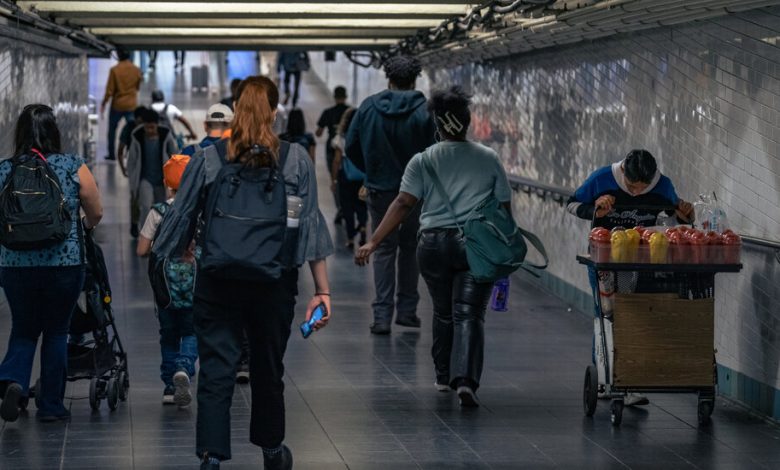Turning to Street Vending, New Migrants Find a Competitive World

Standing on a subway platform deep below Times Square, Natalí Tualombo, a newly arrived migrant from Ecuador, sold water bottles and sodas from a cooler, her 4-year-old son sitting at her feet.
Listen to This Article
Listen to this story in the New York Times Audio app on iOS.
It has become an increasingly familiar sight in New York City, where nearly 120,000 migrants have arrived since spring 2022. Ms. Tualombo said she decided to make money this way after struggling to find a cleaning job.
She frequently dodges not only the police, but also other vendors inside the 42nd Street station. She moved to this platform after a longtime fruit seller on a nearby platform accused her of encroaching on pre-existing turf, threatened to call the police to take her son away and began selling water bottles to compete directly with her, Ms. Tualombo said.
Ms. Tualombo, 23, is scared to keep vending but has limited options. Her husband often comes home empty-handed after searching for day laborer jobs. She brings an apple for her son to eat while she works, sometimes until 10 p.m., to try and make at least $60 for the day.
“I can’t get ahead,” Ms. Tualombo said in Spanish as a subway train screeched by every few minutes. “I look for work, I can’t find any. That’s why I come and suffer here with my son.”
In many corners of New York, the most visible sign of the city’s migrant crisis is on the streets and in the subways, where a surge of newcomers has been hustling to make a living. Faced with a daunting process to obtain formal work authorization, many migrants have joined the competitive world of street vending — hawking candy, fruit and beverages, often with young children in tow.
For decades, street vending has been a first stop for the city’s newest immigrants. But the sudden influx of newcomers has exacerbated tensions between street vendors, who have long fought to escape law enforcement scrutiny and to win turf battles in a city where vending rules are confusing and unevenly enforced.

Roosevelt Avenue in Queens is a popular spot for street vendors, many of whom struggle to obtain permits to sell their goods legally.Credit…Juan Arredondo for The New York Times
The tensions underscore the formidable obstacles confronting new migrants, many of whom are unusually ill-equipped to begin the process of finding steady work. Unlike prior waves of immigrants, many of the latest arrivals have no friends or relatives in New York, entering a shelter system that is struggling to house the 60,000 of them who need the city’s care. They often arrive without a working phone number.
Last month, the Biden administration said it would allow the estimated 472,000 Venezuelans who arrived in the United States before July 31 to live and work legally for 18 months, at least 10,000 of whom might be eligible to apply in New York — although it was not clear how quickly the permits could be granted.
In the meantime, the migrants, from Venezuela and elsewhere, are finding any margins in the informal economy where they can make money without legal papers, including on the streets.
Jorge Pirela, 36, has been selling lollipops from a bag since he and his family arrived in the country from Venezuela on July 18.
On a recent Tuesday, as pedestrians passed him on the sidewalk along Roosevelt Avenue in Corona, Queens, he said in Spanish, “Would you like to support me, friend?”
His wife, Lorena Briseño, 42, tried to calm their 2-year-old daughter and 3-year-old son, who were running up and down the sidewalk, screaming and laughing next to oncoming traffic.
The food at their migrant shelter in Jamaica, Queens, has been giving the children upset stomachs, so they sell candy in order to buy soup or cornflakes. It’s never enough to feed the whole family; on a good day, they make about $15 in two hours.
Mr. Pirela wants to get a job in construction, the industry in which he worked back home. But the couple share a cellphone that only works with a Wi-Fi connection, making it difficult for prospective employers to reach them. They cannot afford a MetroCard, so they wait at the subway station until a rider or police officer lets them in.
Mr. Pirela and Ms. Briseño feel ashamed when other vendors in the area tell them to move along. They are concerned about coming off as bad parents, they said, but this is their only child care option.
“We don’t want to do this because this is not a future for them,” Mr. Pirela said in Spanish, gesturing to his children. “I didn’t cross all of Central America and the Darién jungle to come sell lollipops.”
Legally permitted street vendors in New York City have long complained that the authorities unfairly target them with fines and inspections while turning a blind eye to unlicensed vendors. But in interviews, some longtime vendors said that even as they bristled at the increased competition, they felt especially conflicted about seeing the newcomers sell with their children.
“You fight with yourself on these things,” said Dan Rossi, who has operated a hot dog cart in front of the Metropolitan Museum of Art on the Upper East Side of Manhattan for two decades. “They are breaking the law. The only reason I accept this is for the children. When you see the babies strapped to their backs, how can you not want to feed the babies?”
This is the first year that Mr. Rossi has seen women selling sliced fruit in front of the Met, one of the most highly coveted spots in the city for a street vendor.
In interviews, four of the women said they had recently arrived from Ecuador and declined to provide their names. They described seeing verbal altercations between the fruit sellers. One woman said other vendors on the block had reported her to the city, but on one occasion, when the authorities arrived, they let her stay after she pointed repeatedly to her 2-year-old son.
“It’s a fight every day for all of us,” said Barbara Morris, a permitted ice cream vendor who works near the Met. “You can’t say that one group can vend illegally without rules and regulations on the food while another group has to abide by every rule. That’s infuriating.”
But she was sensitive to the difficulties faced by the new migrants. “My heart aches for these women because it’s a very sad situation that they’re being put in,” she said.
Even if they were to obtain work authorization, it would be almost impossible for the new arrivals to secure the proper licenses to vend legally.
The city caps the number of permits given to street vendors seeking to sell food or merchandise, and the wait-lists to get them have more than 10,000 applicants each, according to Carina Kaufman-Gutierrez, deputy director of the Street Vendor Project at the Urban Justice Center, a nonprofit group that assists street vendors.
“Because there’s no way to enter the formal system of vending at this moment, that creates the necessity for there to be more verbal agreements and street smarts,” Ms. Kaufman-Gutierrez said. “So when you think about that from the perspective of an asylum seeker trying to survive, there’s this general feeling of vulnerability and fear.”
Maria Loja, 24, who has been selling sliced fruit for two years around Times Square, said she has noticed the increased competition in recent months. Sometimes, three or four newly arrived fruit vendors will swarm her spot and try to argue with her, inviting more police scrutiny. Ms. Loja said she was recently fined $1,000 for vending without a permit.
“Sometimes I tell them, ‘can you go sell over there?’” Ms. Loja said in Spanish of the newer migrants. “They tell me, ‘There is no owner here. Nobody has papers. This is a foreign city.’”
City leaders said that migrants were being pitted against one another as they bore the brunt of some of New York’s most vexing problems: homeless shelters are





